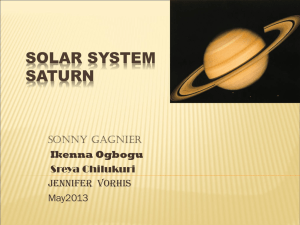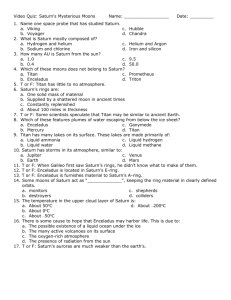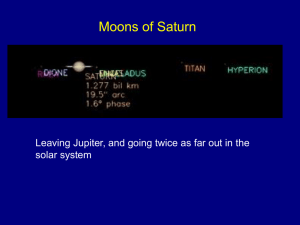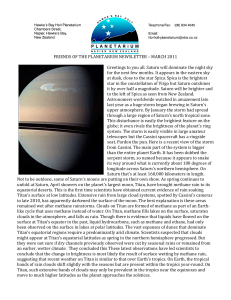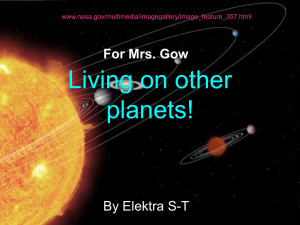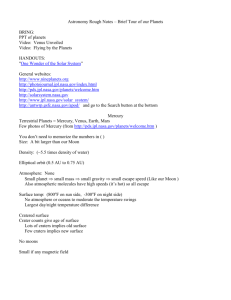PlanetsSessionThree
advertisement
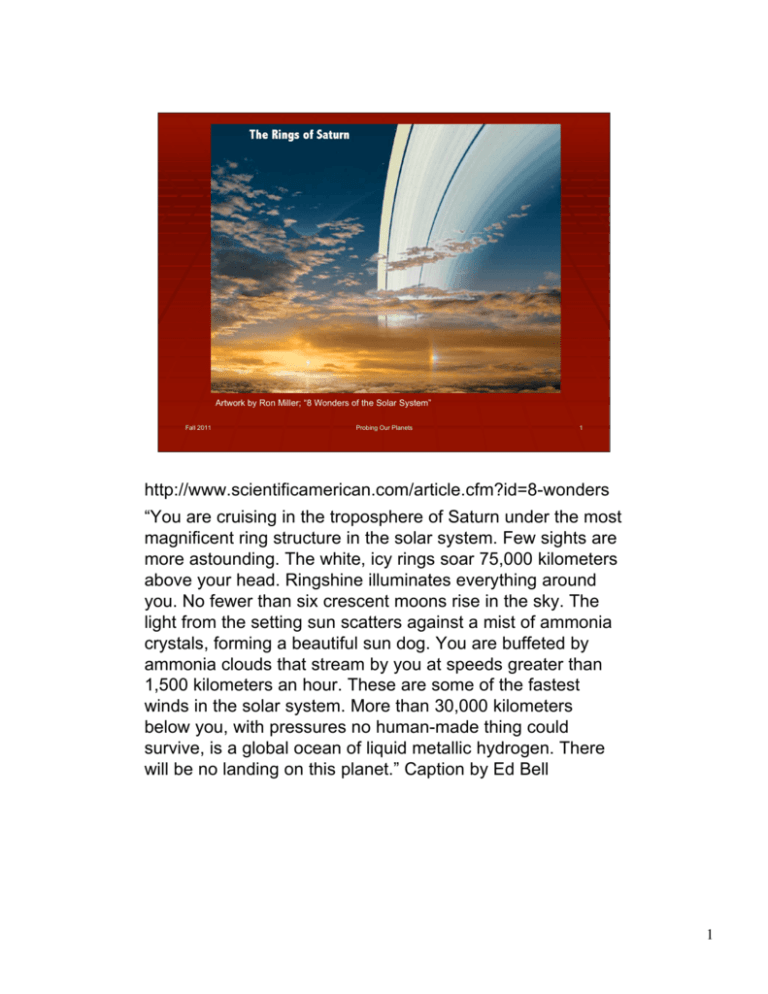
Artwork by Ron Miller; “8 Wonders of the Solar System” Fall 2011 Probing Our Planets 1 http://www.scientificamerican.com/article.cfm?id=8-wonders “You are cruising in the troposphere of Saturn under the most magnificent ring structure in the solar system. Few sights are more astounding. The white, icy rings soar 75,000 kilometers above your head. Ringshine illuminates everything around you. No fewer than six crescent moons rise in the sky. The light from the setting sun scatters against a mist of ammonia crystals, forming a beautiful sun dog. You are buffeted by ammonia clouds that stream by you at speeds greater than 1,500 kilometers an hour. These are some of the fastest winds in the solar system. More than 30,000 kilometers below you, with pressures no human-made thing could survive, is a global ocean of liquid metallic hydrogen. There will be no landing on this planet.” Caption by Ed Bell 1 Cassini to Saturn Impacts recorded while crossing the Ring Plane Rocket science and “Gravitational Slingshots.” Slingshots.” Fall 2011 Probing Our Planets 2 Cassini JPL Home Page: http://saturn.jpl.nasa.gov/index.cfm Cassine NASA Home Page: http://www.nasa.gov/mission_pages/cassini/main/ Trajectory video from: http://saturn.jpl.nasa.gov/video/videodetails/?videoID=18 Rocket Science--Gravity Assist--In orbital mechanics, a gravity assist maneuver or gravitational slingshot uses the relative movement and mutual gravity between a planet and spacecraft to alter the path and speed of a spacecraft at some small cost to the planet’s orbital motion. It is used in order to save propellant, time, and expense. Gravity assistance can be used to accelerate, decelerate and/or re-direct the path of a spacecraft. The "assist" is provided by an exchange of orbital angular momentum between the two objects. From the perspective of the planet, the spacecraft’s velocity is symmetric but not from the perspective of the Sun! The “trick” has been used from Mariner 10 onwards, including Voyagers’, etc. 2 Cassini Eclipsed Fall 2011 Probing Our Planets 3 Image Credit: Cassini Imaging Team, SSI, JPL, ESA, NASA http://apod.nasa.gov/apod/ap110904.html In the shadow of Saturn, unexpected wonders appear. The robotic Cassini spacecraft now orbiting Saturn drifted in giant planet's shadow for about 12 hours in 2006 and looked back toward the eclipsed Sun. Cassini saw a view unlike any other. First, the night side of Saturn is seen to be partly lit by light reflected from its own majestic ring system. Next, the rings themselves appear dark when silhouetted against Saturn, but quite bright when viewed away from Saturn, slightly scattering sunlight, in this exaggerated color image. Saturn's rings light up so much that new rings were discovered, although they are hard to see in the image. Seen in spectacular detail, however, is Saturn's E ring, the ring created by the newly discovered ice-fountains of the moon Enceladus and the outermost ring visible above. Far in the distance, at the left, just above the bright main rings, is the almost ignorable pale blue dot of Earth. 3 Survey of Spectra Sir Isaac Newton (1642-1726) Somewhat fanciful view of actual experiments in 1660’ 1660’s “Opticks, Opticks,” 1704 Fall 2011 Probing Our Planets 4 Isaac Newton & Spectra Through a brilliant series of experiments, Newton showed that the colors displayed in a rainbow are inherent in white light itself. Later physicists showed that visible light was just a human being’s eye’s physical response to one tiny part of a larger electromagnetic wave spectrum. The visible portion of the spectrum extends on both red and blue sides into invisible forms of radiation. Red light has longer wavelengths than blue light and Infrared light has longer wavelengths still. Ultraviolet or “black light” has wavelengths shorter than blues and violet. Infrared radiation is perceived by our body as heat rays; ultraviolet is not directly perceived but causes sunburn and skin cancer. 4 Electromagnetic Spectrum Fall 2011 Probing Our Planets 5 Image © UC Regents from UC Berkeley “Living with a star.” http://ds9.ssl.berkeley.edu/LWS_GEMS/2/espec.htm Images taken using wavelengths of radiation invisible to the human eye obviously must be somehow adjusted so humans can interpret them. This is usually done by representing the variations of intensity in the invisible wavelengths through “pseudo color” or “false color” techniques. 5 Hurricane Irene in Visible Light & in Pseudo-color Left: 27 Aug 2011 by GOES-East Fall 2011 Right: 26 Aug 2011 by Aqua Probing Our Planets 6 US landfall on August 27, 2011, on the outer banks of North Carolina. Visible light image shows landfall. Left: Visible light view by GOES-East satellite in geosynchronous orbit. Right: Infrared view by Aqua satellite in high orbit. Here the IR brightness (think shades of “grey”) is replaced with an ordinary spectral color bar. Purple and blue are colder; oranges and reds warmer. For the hurricane we are seeing cloud tops but in other regions we are probably seeing surface land or water temperature. 6 Ground Ivy Photoart by Bjorn Rorslett Visible IR intensity UV filter Lit by Black Light “false colored” Fall 2011 Probing Our Planets 7 http://www.naturfotograf.com/index2.html Upper Left: Illumination--white light; normal color photo; Upper Right: Illumination--white light; Infrared filter shows almost uniform IR reflectivity, that is to say, the flower and leaves are at essentially the same temperature. Lower Left: Illumination--white light; Ultraviolet filtered image has been “false-colored” to emphasize contrast. Lower Right: Illumination--black light; but normal color image showing the fluorescence in visible light of the flower’s anthers. “It should be realised that there cannot possibly be any "true" colour rendition of the irradiation outside the spectral band visible to our eyes. We are entirely free to select any colour scheme of our own liking. Thus, my images should not be compared directly to other people's pictures as far as colours are concerned. I have to stress this often neglected fact because many believe UV or IR has just one "correct" rendition, while in reality there are as many possibilities as you can imagine. Thus, seeing my pictures and stating "UV is rich in red" is meaningless (but people do this).” 7 Image (PIA13405) Credit: NASA/JPL/ASI/University of Arizona http://photojournal.jpl.nasa.gov/catalog/PIA13405 This false-color composite image, constructed from data obtained by NASA's Cassini spacecraft, shows Saturn's rings and southern hemisphere. The composite image was made from 65 individual observations by Cassini's visual and infrared mapping spectrometer in the near-infrared portion of the light spectrum on Nov. 1, 2008. The observations were each six minutes long. In this image constructed from data collected in the near-infrared wavelengths of light, scientists designated blue to indicate sunlight reflected at a wavelength of 2 microns, green to indicate sunlight reflected at 3 microns and red to indicate thermal emission at 5 microns. Saturn's rings reflect sunlight at 2 microns, but not at 3 and 5 microns, so they appear deep blue. Saturn's high altitude haze reflects sunlight at both 2 and 3 microns, but not at 5 microns, and so it appears green to blue-green. The heat emission from the interior of Saturn is only seen at 5 microns wavelength in the spectrometer data, and thus appears red. The dark spots and banded features in the image are clouds and small storms that outline the deeper weather systems and circulation patterns of the planet. They are illuminated from underneath by Saturn's thermal emission, and thus appear in silhouette. 8 Fall 2011 Probing Our Planets 9 Image (PIA09212) Credit: NASA/JPL/University of Arizona This striking false-color mosaic was created from 25 images taken by Cassini's visual and infrared mapping spectrometer over a period of 13 hours, on Feb. 24, 2007, and captures Saturn in nighttime and daytime conditions. The visual and infrared mapping spectrometer acquires data simultaneously at 352 different wavelengths, or spectral channels. Data at wavelengths of 2.3, 3.0 and 5.1 microns were combined in the blue, green and red channels. At 2.3 microns (shown in blue), the icy ring particles are highly reflecting, while methane gas in Saturn's atmosphere strongly absorbs sunlight and renders the planet very dark. At 3.0 microns (shown in green), the situation is reversed: water ice in the rings is strongly absorbing, while the planet's sunlit hemisphere is bright. Thus the rings appear blue in this representation, while the sunlit side of Saturn is greenish-yellow in color. Within the rings, the most opaque parts appear dark, while the more translucent regions are brighter. In particular, the opaque, normally-bright B ring appears here as a broad, dark band separating the brighter A (outer) and C (inner) rings. At 5.1 microns (shown in red), reflected sunlight is weak and thus light from the planet is dominated by thermal (i.e., heat) radiation that wells up from the planet's deep atmosphere. This thermal emission dominates Saturn's dark side as well as the north polar region (where the hexagon is again visible) and the shadow cast by the A and B rings. 9 Saturn’s Auroras Fall 2011 Probing Our Planets 10 Image (PIA06436) Credit: NASA/JPL/University of Colorado http://photojournal.jpl.nasa.gov/catalog/PIA06436 Images taken on June 21, 2005, with Cassini's ultraviolet imaging spectrograph are the first from the mission to capture the entire "oval" of the auroral emissions at Saturn's south pole. In the side-by-side, false-color images, taken about one hour apart, blue represents aurora emissions from hydrogen gas excited by electron bombardment, while red-orange represents reflected sunlight. The images show that the aurora lights at the polar regions respond rapidly to changes in the solar wind. The same process produces auroras on both planets: variations in the plasma environment release trapped electrons, which stream along the magnetic field lines into the upper atmosphere. There, they collide with atoms and molecules, exciting them to higher energies. The atoms and molecules release this added energy by radiating light at particular characteristic colors and wavelengths. On Earth, this light is mostly from oxygen atoms and nitrogen molecules. On Saturn, it is from emissions of molecular and atomic hydrogen. 10 Lightning Storms Fall 2011 Probing Our Planets 11 Credit: NASA/JPL/University of Iowa http://saturn.jpl.nasa.gov/video/videodetails/?videoID=111 Lightning Sounds from Saturn This audio clip was created from radio signals received by the radio and plasma wave science instrument on the Cassini spacecraft. The bursty radio emissions were generated by lightning flashes on Saturn and are similar to the crackles and pops one hears on an AM radio during a thunderstorm on Earth. This storm on Saturn occurred on January 23 and 24, 2006. The clip compresses two hours of observations into about 28 seconds. Therefore, every second of the audio clip corresponds to about 4 minutes, 18 seconds. 11 Fall 2011 Probing Our Planets 12 Image (PIA08388) Credit: NASA/JPL/Space Science Institute http://photojournal.jpl.nasa.gov/catalog/PIA08388 Little light makes its way through the rings to be scattered in Cassini's direction in this viewing geometry, making the rings appear somewhat dark compared to the reflective planet. . This mosaic was constructed from wide-angle camera images taken just before the narrow-angle camera mosaic PIA08389. The view combines 45 images -- 15 separate sets of red, green and blue images--taken over the course of about two hours, as Cassini scanned across the entire main ring system. The images in this view were obtained on May 9, 2007, at a distance of approximately 1.1 million kilometers (700,000 miles) from Saturn. Image scale is about 62 kilometers (39 miles) per pixel. 12 Saturn’s A Ring in the UV Fall 2011 Probing Our Planets 13 Image (PIA05075) Credit: NASA/JPL/University of Colorado http://www.nasa.gov/mission_pages/cassini/multimedia/gallery/gallery-index.html This ultraviolet view indicates there is more ice toward the outer part of the rings, than in the inner part, hinting at the origins of the rings and their evolution. Images taken during the Cassini spacecraft's orbital insertion on June 30 show compositional variation in the A, B and C rings. From the inside out, the "Cassini Division" in faint red at left is followed by the A ring in its entirety. The Cassini Division at left contains thinner, dirtier rings than the turquoise A ring, indicating a more icy composition. The red band roughly three-fourths of the way outward in the A ring is known as the Encke gap. The ring system begins from the inside out with the D, C, B and A rings followed by the F, G and E rings. The red in the image indicates sparser ringlets likely made of "dirty," and possibly smaller, particles than in the icier turquoise ringlets. 13 High Resolution View of Rings Rings consist of countless small particles, ranging in size from micrometers to meters, that form clumps that in turn individually orbit about Saturn. The ring particles are made of 99.9% of water ice, with some contamination from dust and other chemicals. The system is perhaps 75,000 km wide but only 10 meters thick. Fall 2011 Probing Our Planets 14 Image (PIA08389) Credit: NASA/JPL/Space Science Institute http://photojournal.jpl.nasa.gov/catalog/PIA08389 Incredible complexity but precision and order. Saturn is to the left. What is the composition? Dirty ice, water ice, in forms probably down to the size of snowflakes, clumps of ice the size of snowballs and maybe even dump truck sized bolders of ice, mixed with crushed rock and organic goo. The view combines 45 narrow-angle images -- 15 separate sets of red, green and blue images -- taken over the course of about 2.5 hours, as Cassini scanned across the rings. The images in this view were obtained on May 9, 2007, at a distance of approximately 1.1 million kilometers (700,000 miles) from Saturn. 14 Shepherds Prometheus & Pandora Fall 2011 Probing Our Planets 15 Image (PIA 07712) Credit: NASA/JPL/Space Science Institute http://ciclops.org/view.php?id=1361&js=1 This movie sequence from Cassini shows dark drapes in the inner strands of the F ring caused by the gravitational influence of the shepherd moon Prometheus (86 kilometers, 53 miles across). Prometheus appears first in the sequence, interior to the F ring, and Pandora (81 kilometers, 50 miles across) follows along outside of the ring. Prometheus orbits closer to Saturn, and thus faster, than the icy particles that make up the F ring. Each apoapse passage causes greatest effect. On the next apoapse passage of Prometheus, a new gore in the inner ring material is made. The gores, together with the sheared-out material due to differential orbital motion, create the dark, diagonal drapes. The visible light images in this sequence were acquired using the narrow angle camera on April 13, 2005 from a distance of approximately 1.2 million kilometers (700,000 miles) from Saturn. 15 Titan Fall 2011 Probing Our Planets 16 Image (PIA09833) Credit: NASA/JPL/Space Science Institute http://photojournal.jpl.nasa.gov/catalog/PIA09833 Titan's atmosphere is the only dense, nitrogen-rich atmosphere in the Solar System aside from the Earth's. The atmospheric composition in the stratosphere is 98.4% nitrogen with the remaining 1.6% composed mostly of methane (1.4%) and hydrogen (0.1–0.2%). There are trace amounts of other hydrocarbons, such as ethane, acetylene and propane, hydrogen cyanide, carbon dioxide, carbon monoxide, cyanogen, argon and helium. The orange color as seen from space must be produced by other more complex chemicals in small quantities, possibly tholins, tar-like organic precipitates. The hydrocarbons are thought to form in Titan's upper atmosphere in reactions resulting from the breakup of methane by the Sun's ultraviolet light, producing a thick orange smog. Titan has no magnetic field, 16 Huygens Descent without bells & whistles Fall 2011 Probing Our Planets 17 Huygens Descent Data Movie without Bells and Whistles Credit: ESA/NASA/JPL/University of Arizona http://saturn.jpl.nasa.gov/video/videodetails/?videoID=127 This movie was built with data collected during the 147-minute plunge through Titan's thick orange-brown atmosphere to a soft sandy riverbed by the European Space Agency's Huygens Descent Imager/Spectral Radiometer on Jan. 14, 2005, In 4 minutes and 40 seconds, the movie shows what the probe 'saw' within the few hours of the descent and the landing. On approach, Titan appeared as just a little disk in the sky among the stars, but after landing, the probe's camera resolved little grains of sand millions of times smaller than Titan. At first, the Huygens camera just saw fog over the distant surface. The fog started to clear only at about 60 kilometers (37 miles) altitude, making it possible to resolve surface features as large as 100 meters (328 feet). Only after landing could the probe's camera resolve the little grains of sand. The movie provides a glimpse of such a huge change of scale. 17 Huygens Descent with bells & whistles Fall 2011 Probing Our Planets 18 Huygens Descent Data Movie with Bells and Whistles Credit: ESA/NASA/JPL/University of Arizona http://saturn.jpl.nasa.gov/video/videodetails/?videoID=126 The almost four-hour-long operation of the camera is shown in less than five minutes. That's 40 times the actual speed up to landing and 100 times the actual speed thereafter. The first part of the movie shows how Titan looked to the camera as it acquired more and more images during the probe's descent. Each image has a small field of view, and dozens of images were made into mosaics of the whole scene. The scientists analyzed Huygens' speed, direction of motion, rotation and swinging during the descent. For details on the graphics displayed go to the web site. 18 Titan’s North Polar Surface Fall 2011 Probing Our Planets 19 Image (PIA10008) Credit: NASA/JPL/USGS http://photojournal.jpl.nasa.gov/catalog/PIA10008 This Cassini false-color mosaic shows radar images of Titan's north polar region.. About 14 percent of the mapped region is covered by liquid hydrocarbon lakes. Features thought to be liquid are shown in blue and black, and the areas likely to be solid surface are tinted brown. These seas are most likely filled with liquid ethane, methane and dissolved nitrogen. Many bays, islands and tributary networks are associated with the seas. The large feature in the upper right center of this image is at least 100,000 square kilometers (40,000 square miles) in area, greater in extent than Lake Superior (82,000 square kilometers or 32,000 square miles), one of Earth's largest lakes. This Titan feature covers a greater fraction of the surface, at least 0.12 percent, than the Black Sea, Earth's largest terrestrial inland sea, at 0.085 percent. Of the 400 observed lakes and seas, 70 percent of their area is taken up by large "seas" greater than 26,000 square kilometers (10,000 square miles). 19 Titan’s Lakes of light liquefied petroleum gases Fall 2011 Probing Our Planets 20 Image (PIA09102) Credit: NASA/JPL/USGS http://photojournal.jpl.nasa.gov/catalog/PIA09102 The existence of oceans or lakes of liquid methane on Titan was predicted more than 20 years ago. But unconfirmed until the Cassini flyby of July 22, 2006. This false color radar image, used on the journal Nature’s cover, gives a taste of what Cassini saw. Intensity is proportional to how much radar brightness is returned. The lakes, darker than the surrounding terrain, are emphasized here by tinting regions of low backscatter in blue. Radar-brighter regions are shown in tan. The strip of radar imagery is foreshortened to simulate an oblique view of the highest latitude region, seen from a point to its west. This radar image was acquired by the Cassini radar instrument in synthetic aperture mode on July 22, 2006. The image is centered near 80 degrees north, 35 degrees west and is about 140 kilometers (84 miles) across. Smallest details in this image are about 500 meters (1,640 feet) across. 20 Artwork by Ron Miller; “8 Wonders of the Solar System” Fall 2011 Probing Our Planets 21 http://www.scientificamerican.com/article.cfm?id=8-wonders The Geysers of Enceladus You feel it before you see it: an ominous rumble, reverberating deep in your chest and up from your feet. There is no sound here. And then the eruption comes: two huge ice plumes explode through the surface of Enceladus, spewing ice crystals into space at more than 1,000 miles per hour. The silent violence is lit by our distant sun. With just 1/16 of our own moon's gravity, Enceladus will not be an easy world to tread on; hikers may need to strap on jetpacks and take care to avoid the valleys that give birth to the powerful geysers. Caption by Ed Bell 21 Ice Fountains on Enceladus (2005) Fall 2011 Probing Our Planets 22 Image (PIA07758) Credit: NASA/JPL/Space Science Institute http://photojournal.jpl.nasa.gov/catalog/PIA07758 Recent Cassini images of Saturn's moon Enceladus backlit by the sun show the fountain-like sources of the fine spray of material that towers over the south polar region. This image was acquired on Nov. 27, 2005. Imaging scientists, as reported in the journal Science on March 10, 2006, believe that the jets are geysers erupting from pressurized subsurface reservoirs of liquid water above 273 degrees Kelvin (0 degrees Celsius). 22 Ice Plumes of Enceladus (2005) Fall 2011 Probing Our Planets 23 Image (PIA08386) Credit: NASA/JPL/Space Science Inst. Cassini imaging scientists used views like this one to help them identify the source locations for individual jets spurting ice particles, water vapor and trace organic compounds from the surface of Saturn's moon Enceladus. This false-color view was created by combining three clear filter images taken at nearly the same time as PIA07759. This image product was then specially processed to enhance the individual jets that compose the plume. Some artifacts due to the processing are present in the image. The final product was colored as blue for dramatic effect. The images were acquired with the Cassini spacecraft narrow-angle camera on Nov. 27, 2005 at a distance of approximately 148,000 kilometers (92,000 miles) from Enceladus and at a sun-Enceladus-spacecraft, or phase, angle of 161 degrees. Scale in the original images is about 880 meters (0.5 mile) per pixel. This view has been magnified by a factor of two from the original images. 23 Tiger Stripes at Enceladus’ Enceladus’ South Pole Fall 2011 Probing Our Planets 24 Image (PIA12448) Credit: NASA/JPL/GSFC/SWRI/SSI The right-hand image shows an improved close-up view of heat radiation from a warm fissure near the south pole of Saturn's icy moon Enceladus. It was obtained by NASA's Cassini spacecraft during its Nov. 21, 2009, flyby. The fissure, named Baghdad Sulcus, is one of four so-called "tiger stripe" features that emit jets of water vapor and ice particles. The left image was obtained in March 2008. The new data show that the heat sources previously detected are confined to a narrow, intense region no more than a kilometer (half a mile) wide along the fracture. The thermal image also reveals that the strength of the signal varies considerably along the length of this fissure segment. The composite infrared spectrometer data indicate that the temperature along Baghdad Sulcus reached more than 180 Kelvin (about minus 140 degrees Fahrenheit). The intensity of heat radiation increases as the color shades from violet to red to orange to yellow. No internal heat was detected in the darkest violet regions, and uncolored regions were not mapped by Cassini's composite infrared spectrometer. The background image is derived from visible-light images taken by Cassini's imaging science subsystem cameras in July 2005: alignment of the infrared data with the visible-light map is approximate. The fractures themselves may be even warmer than the 180 Kelvin (minus 140 degrees Fahrenheit) detected -- perhaps warm enough for liquid water to exist under the surface. 24 Ice Plumes of Enceladus (2009) http://saturn Enceladus//enceladus.html http://saturn..jpl. jpl.nasa. nasa.gov/multimedia/flash/ gov/multimedia/flash/Enceladus enceladus.html Fall 2011 Probing Our Planets 25 Image Credit: NASA/JPL/Space Science Institute Dramatic plumes, both large and small, spray water ice out from many locations along the famed "tiger stripes" near the south pole of Saturn's moon Enceladus. The tiger stripes are fissures that spray icy particles, water vapor and organic compounds. More than 30 individual jets of different sizes can be seen in this image and more than 20 of them had not been identified before. At least one jet spouting prominently in previous images now appears less powerful. This mosaic was created from two high-resolution images that were captured by the narrow-angle camera when NASA's Cassini spacecraft flew past Enceladus and through the jets on Nov. 21, 2009. (For other images captured during the same flyby, see PIA11686 and PIA11687). Imaging the jets over time will allow Cassini scientists to study the consistency of their activity. The south pole of the moon lies near the limb in the top left quadrant of the mosaic, near the large jet that is second from left. Lit terrain seen here is on the leading hemisphere of Enceladus (504 kilometers, 313 miles across). Cassini scientists continue to study the question of whether reservoirs of liquid water exist beneath the surface of the moon. 25 Cassini steps into the shadow and looks back Fall 2011 Probing Our Planets 26 http://photojournal.jpl.nasa.gov/catalog/?IDNumber=PIA08324 Earth is captured here in a natural color portrait made possible by the passing of Saturn directly in front of the sun from Cassini's point of view. At the distance of Saturn's orbit, Earth is too narrowly separated from the sun for the spacecraft to safely point its cameras and other instruments toward its birthplace without protection from the sun's glare.The Earth-and-moon system is visible as a bright blue point on the right side of the image above center. Here, Cassini is looking down on the Atlantic Ocean and the western coast of north Africa. The Saturnian moon, Enceladus, is among them, and is also captured on the left in this image, with its plume of water ice particles and swathed in the blue E ring which it creates. Delicate fingers of material extend from the active moon into the E ring. The narrow tenuous G ring and the main rings are seen at the right. The view looks down from about 15 degrees above the un-illuminated side of the rings.Images taken using red, green and blue spectral filters were combined to create this view. The image was taken by the Cassini spacecraft wide-angle camera on Sept. 15, 2006, at a distance of approximately 2.1 million kilometers (1.3 million miles) from Saturn and at a sun-Saturn-spacecraft angle of almost 179 degrees. Image scale is approximately 250 kilometers (155 miles) per pixel.At this time, Cassini was nearly 1.5 billion kilometers (930 million miles) from Earth. 26 Enceladus & the E Ring Fall 2011 Probing Our Planets 27 Image (PIA08321) Credit: NASA/JPL/Space Science Institute http://photojournal.jpl.nasa.gov/catalog/?IDNumber=PIA08321 Wispy fingers of bright, icy material reach tens of thousands of kilometers outward from Saturn's moon Enceladus into the E ring, while the moon's active south polar jets continue to fire away. The sun-Enceladus-spacecraft angle here is 175 degrees, a viewing geometry in which structures made of tiny particles brighten substantially. These features are very likely the result of particles injected into Saturn orbit by the Enceladus geysers. In addition to the wisps, another unexpected detail is the dark gore in the center of the ring, following the moon in its orbit, likely brought about by the sweeping action of Enceladus as it orbits in the center of the E ring. The view looks down onto Enceladus (505 kilometers, or 314 miles across) from about 15 degrees above the ringplane. Tethys (1,071 kilometers, or 665 miles across) is visible to the left of Enceladus. The image was taken in visible light on Sept. 15, 2006, at a distance of approximately 2.1 million kilometers (1.3 million miles) from Enceladus. Image scale is 128 kilometers (80 miles) per pixel. 27 Varied Moons Icy Helene (~25 miles across Co-orbital with Dione & Polydeuces) Phoebe (~135 miles across, dark as lampblack) Fall 2011 Probing Our Planets Hyperion (~225 miles long, spongy) Dark Dione (~700 miles across Co-orbital with Telesto & Calypso) & Bright Tethys (~660 miles across) 28 To date, 62 moons have been discovered, 53 moons have been officially named. (Pre-launch Cassini Mission handout says 18 moons.) The dozens of icy moons orbiting Saturn vary drastically in shape, size, surface age and origin. Some of these worlds have hard, rough surfaces, while others are porous bodies coated in a fine blanket of icy particles. All have greater or smaller numbers of craters, and many have ridges and valleys. Some, like Dione and Tethys, show evidence of tectonic activity, where forces from within ripped apart their surfaces. Many, like Rhea and Tethys, appear to have formed billions of years ago, while others, like Janus and Epimetheus, could have originally been part of larger bodies that broke up. The study and comparison of these moons tells us a great deal about the history of the Saturn System and of the solar system at large. 28 Mimas, Saturn’s “Death Star” Fall 2011 Probing Our Planets 29 Mimas is a moon of Saturn which was discovered in 1789 by William Herschel. It is named after Mimas, a son of Gaia in Greek mythology, and is also designated Saturn I. By diameter (~250 miles/396 kilometers) the twentieth-largest moon in the Solar System, Mimas is the smallest known astronomical body that is thought to be rounded in shape due to self-gravitation The low density of Mimas, 1.15 g/cm3, indicates that it is composed mostly of water ice with only a small amount of rock. Mimas' most distinctive feature is a colossal impact crater 130 kilometres (81 mi) across, named Herschel after the moon's discoverer. Herschel's diameter is almost a third of the moon's own diameter; its walls are approximately 5 kilometres (3.1 mi) high, parts of its floor measure 10 kilometres (6.2 mi) deep, and its central peak rises 6 kilometres (3.7 mi) above the crater floor. If there were a crater of an equivalent scale on Earth it would be over 4,000 kilometres (2,500 mi) in diameter, wider than Australia. The impact that made this crater must have nearly shattered Mimas: fractures can be seen on the opposite side of Mimas that may have been created by shock waves from the impact travelling through the moon's body. 29 Herschel Crater on Mimas Fall 2011 Probing Our Planets 30 http://apod.nasa.gov/apod/ap100511.html APOD caption: Why is this giant crater on Mimas oddly colored? Mimas, one of the smaller round moons of Saturn, sports Herschel crater, one of the larger impact craters in the entire Solar System. The robotic Cassini spacecraft now orbiting Saturn took the above image of Herschel crater in unprecedented detail while making a 10,000-kilometer record close pass by the icy world just over one month ago. Shown in contrast-enhanced false color, the above image includes color information from older Mimas images that together show more clearly that Herschel's landscape is colored slightly differently from more heavily cratered terrain nearby. The color difference could yield surface composition clues to the violent history of Mimas. An impact on Mimas much larger than the one that created the 130-kilometer Herschel would likely have destroyed the entire world. 30


